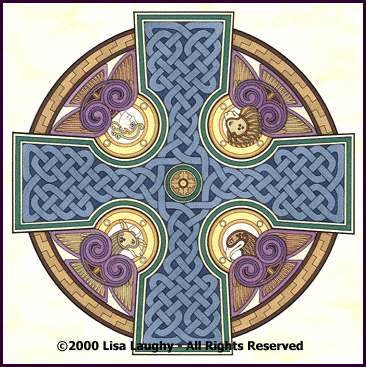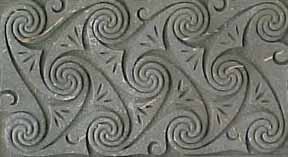|
Symbols of the
Evangelists
The four winged creatures of the prophesies of Ezekiel
and The Revelations of St. John came to be identified with the
four Evangelists in early Christian symbolism as early as the 2nd
century. The Man symbolized St. Mathew, the Lion St. Mark, the
Calf St.
Luke and the Eagle St. John. In the 4th century, St. Gregory wrote
a commentary on Ezekiel identifying the four symbols as the stages of
Christ's life. Christ was born a man, in his death he was sacrificed as
a calf, a lion in his resurrection and an eagle in his ascension to
heaven.
In early Gospel books, including the great Celtic
Gospel manuscripts of Kells and Durrow, the symbols of the
Evangelists were represented arrayed around the cross and also
individually at the beginning each Gospel. Reproduced details from these
historic sources as well as original compositions in the Celtic
tradition have drawn on these sources, such as the Evangelists Cross
by artist Lisa Laughy
shown on the left. |

|
|
Spirals

After interlace, spirals are the most commonly recognized
of Celtic design motifs. Spirals are among the most primal of the human
artistic vocabulary and are found in most artistic traditions. Spirals
adorn Irish Stone Age monuments at Newgrange, dating from 2,500 B.
C. The La Tene style of spiral ornament is the defining
artistic characteristic of the Celtic Iron Age. In the Golden Age of
Celtic Art, beginning in the 7th century A. D. a very complex style of
spiral ornament emerged that is referred to as Ultimate La Tene.
|
Spirals in nature such as snails or
plants and in natural phenomena
such as whirlpools or galaxies, give the mind much in the way of
metaphors for cosmic symbolism. These sort of nature relationships are
frequently and quite validly used by modern Celtic artists as symbolic
content.
Another school of though gives significance
to the direction of the spirals. Clockwise or sunwise circling, a'deasail,
is traditional in Gaelic blessing gestures and good-luck practices. To
move sun-wise is to be in harmony with the earth. Conversely geis
or spells are made with anti-sun-wise motion. This gets a little tricky
since spirals may be read as either flowing inwards or outwards. Many
spiral arrangements contain equal numbers of whorls going each way and
are thus in balance. The numbers of whorls or the number of arms of
spirals can be used as number symbols, the most common being three for
the Holy Trinity and four for the Four Directions.
Like knotwork, the style of spirals themselves are
in modern times symbolic as an emblem of Celtic culture. There is no
hard and fast universal meaning for Celtic spirals. They may be created
simply for the sake or their beauty but there is much
room for creative and imaginative, even playful interpretations.
Click for an article by artist Jen
Delyth on the symbolism of spirals and Celtic design
|
Illustrations, listed from top of the page:
MacLean's Cross, 15th c. Isle of Iona
Spiral panel from Celtic Revival monument, Glasnevin Cemetery Dublin
Saint Andrew Knot emblem, design 1990
Landscape Triquetra, Isle of Iona 2000
Wedding ring and Heart knot pin, Walker Metalsmiths 1995
Celtic Cross, Celtic Revival monument, Glasnevin Cemetery Dublin
Spiral panel from Celtic Revival monument, Glasnevin Cemetery Dublin |
Articles by Stephen Walker
published in
Dalriada Magazine
Celtic Interlace; An Overview Part 1
Celtic
Interlace; Continuum Part 2
Celtic
Interlace; Continuum Continued (part 3)
In Search of
Meaning (part 4)
Celtic
Art of Jeff Fitzpatrick This web page was
created by Stephen Walker (C) Copyright 2006-2008. All rights reserved.
updated 2013
Walker
Metalsmiths Celtic Jewelry
|






